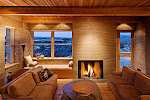

I do allot of stitching these days for clients, usually a half dozen+ on every shoot. An effective stitching program is a must. I have stated before that I prefer Photoshop CS4 Photomerge over programs like Autopano Pro or PT Gui for flat stitched architectural images and the images below will illustrate why. Above are jpegs of the original raw files, Canon 5DM2, Canon 24T/S. The method was to simply level the camera-shift up and expose and shift down and expose. NOTE, the camera must be on manual exposure and the white balance set (4000 K on this) so that the exposure and white balance does not change automatically between exposures (I only use manual exposure normally for architecture anyway and expose based on the histogram). Below are the renderings of the images in Photoshop Photomerge and Autopano Pro. AutoPano Pro with its "best" projection mode (Planar in this case). It introduces allot of pincussioning that requires additional time in PS to correct.

This file is straight from the raw files in bridge via the PS Photomerge script. Photoshop Photomerge preserves much better the straight lines of the original files,

I find Autopano Pro to be superior for large multi-tiled landscape stitches. It seems superior at blending edges in skies and finding control points in clouds etc. But for my daily architecture bread and butter with Tilt/Shift lenses? Give me Photoshop CS4 Photomerge.
I discovered this problem with architecture in Autopano Pro this week because my PS Photomerge could not align any two images to save its life. With deadlines to meet, I was panicking. So I tried Autopano Pro and PT Gui again. Neither performed as well as simple PS Photomerge. It turns out that my problem in PS was a corrupted Preferences file and as soon as I erased that (the program will recreate it) the stitch program in PS ran fine. People tell me that it is a good idea to save a clean copy of your preferences file and replace the existing one at the first sign of trouble in PS. Where this is located depends on your operating system and PS version. So you will have to investigate this online. It is a fairly well known issue apparently.
For an alternative take on AutopanoPro see Jack Flesher's post on LL
The Kira Sowanick, AIA, Residence, Albuquerque, NM.













No comments:
Post a Comment